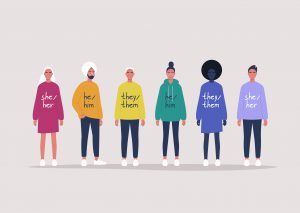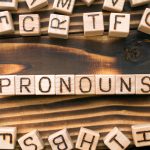She/her/hers
He/him/his
They/them/theirs
Ze/zir/zirs
Xe/xem/xyrs
Pronouns are the words we use in place of proper names. They are also a signifier for someone's gender identity. But, you can't always know someone's gender identity just by looking at them. When you use the wrong one or make assumptions, you are erasing a person's identity and potentially sending a harmful message. A step that you can take to avoid sending a harmful message is to clarify a person's pronouns. It is an act of inclusivity and respect.
At Pima County Public Library, we value diversity—serving everyone and finding strength in celebrating our differences. When we are made aware of a person's pronouns, whether staff or a member of the public, we use them. Why? There are lots of reasons—here are some to consider:
- It alleviates pressure on an individual to make an announcement, possibly putting them in an uncomfortable position.
- It's a simple and respectful way to normalize discussion about gender.
- It creates a more welcoming and inclusive workplace.
- It is one of the most basic ways to show respect for a person's gender identity.
- It sets a tone of allyship and can make a difference for those who may feel vulnerable.
- It is a learning opportunity.
- It is a way to show people that you don't assume gender identity is based on appearance.
Unsure of how to do it? Here are some ways you can ask a person what their preferred pronouns are:
- "What pronouns do you use?"
- "How would you like me to refer to you?"
- "How would you like to be addressed?"
- "Can you remind me which pronouns you like for yourself?"
- "My pronouns are he, him, and his. What about you?"
You may find it difficult to use gender-neutral language at first, but you can do it! According to the Gay, Lesbian & Straight Education Network, opens a new window (GLSEN), here are some tips to keep in mind:
- Practice, practice, practice! Use gender-neutral pronouns such as “they” and “ze” while visualizing the person who uses them. This is especially useful to do right before you’re about to see the person.
- If you know someone who has changed pronouns, practice by retelling your favorite memory of them using their new pronouns.
- When addressing groups of people or people whose pronouns you haven’t been told, use gender-neutral language such as, “siblings,” “third graders,” “students”, “friends,” “folks,” “all,” or “y’all,” rather than “brothers and sisters,” or “guys,” “ladies,” “ma’am,” or “sir.”
- Use descriptive language if you do not know a person’s gender, pronouns, or name. e.g. Can you give this paper to the person across the room with the white t-shirt and short brown hair?
Want to learn more? Here are some resources about the recent expansion of pronouns:
- Everything You Ever Wanted to Know About Gender-Neutral Pronouns (Motto/Time, May 2016)
- Gender Pronouns (UWM LGBT Resource Center, 2018)
- They Is My Pronoun (blog, regularly updated)
-
Resources (International Pronouns Day)



